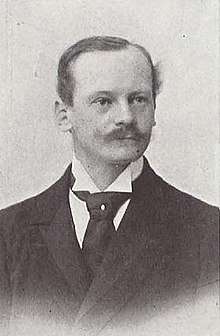Otto Jaekel
Otto Max Johannes Jaekel (21 February 1863 – 6 March 1929) was a German paleontologist and geologist.
Otto Jaekel | |
|---|---|
 | |
| Born | 21 February 1863 |
| Died | 6 March 1929 (aged 66) |
| Scientific career | |
| Fields | |
| Institutions | Berlin, Greifswald |
Jaekel was born in Neusalz (Nowa Sól), Prussian Silesia. He studied geology and paleontology in Liegnitz (Legnica). After graduating in 1883, he moved to Breslau (Wrocław) and studied under Ferdinand Roemer until 1885. Karl von Zittel awarded a PhD to Jaekel in Munich in 1886. Between 1887 and 1889, Jaekel was an assistant of E.W. Benecke at the Geologisch-Paläontologisches Institut in Straßburg, where he received his Habilitation. He worked at the Friedrich-Wilhelms-Universität Berlin and at the Geologisch-Paläontologisches Museum (a combined post) from 1894. Jaekel was considered as an ordinary professor of geology at the University of Vienna in 1903, but this was blocked by intrigue. Between 1906 and 1928, Jaekel was a professor at the University of Greifswald,[1] where he founded the German Paleontological Society in 1912. He described a second species of Plateosaurus in 1914.
During World War I, in which he served as a Hauptmann (Captain) in the 210th Prussian Infantry Regiment, he attempted to re-start excavations at the southern Belgian town of Bernissart, where several dozen specimens of the dinosaur Iguanodon had been dug up in the 1870s.[2] Although he eventually succeeded in persuading the German occupation authorities to support his initiative, the attempt had to be abandoned after the German army surrendered in November 1918.
After his retirement in Greifswald, Otto Jaekel accepted a position at Sun Yat-sen University in Guangzhou in 1928. He died after a short and unexpected illness in the German Hospital in Beijing.[3]
As a paleontologist, Jaekel specialized in the study of fossil vertebrates, particularly fishes and reptiles. However, 27 of his publications were about echinodermata. In addition, he wrote about politics, literature and art. He was an accomplished painter, and used his skills to produce landscape paintings that illustrate the geology of the Pomeranian coast.
Works
- Jaekel, Otto. 1896. “Über die Stammform der Wirbelthiere.” Sitzungsberichte der Gesellschaft Naturforschender Freunde zu Berlin 7 107–29.
- Jaekel, Otto. 1899. Stammesgeschichte der Pelmatozoen: Thecoidea und Cystoidea. Berlin: Julius Springer.
- Jaekel, Otto. 1903. “Besprechung des ersten Berichts des Geologischen Beratungs-Komitees für das Carnegie-Institut in Washington.” Zeitschrift der Deutschen Geologischen Gesellschaft 73–76.
- Jaekel, Otto. 1904. “Eine neue Darstellung von Ichthyosaurus.” Zeitschrift der deutschen geologischen Gesellschaft 26–34.
- Jaekel, Otto. 1904. “K.A. V. Zittel, Der Altmeister der Paläontologie.” Naturwissenschaftliche Wochenschrift 1–7.
- Jaekel, Otto. 1905. “Die Bedeutung der Wirbelstacheln der Naosauriden.” Zeitschrift der Deutschen Geologischen Gesellschaft 57 192–95.
- Jaekel, Otto. 1910. “Naosaurus Credneri im Rotliegenden von Sachsen.” Zeitschrift der Deutschen Geologischen Gesellschaft 62 526–35.
- Jaekel, Otto. 1910. “Rekonstruktionen Fossiler Tiere.” In Meyer’s Großes Konversations-Lexikon, 6. Auflage. XXII. Band, Jahressupl. 1909-1910, 712–715, 4 plates. Leipzig & Wien: Bibliographisches Institut.
- Jaekel, Otto. 1910. “Über die Füßstellung und Lebensweise der großen Dinosaurier.” Zeitschrift der Deutschen Geologischen Gesellschaft 62 270–76.
- Jaekel, Otto. 1911. Die Wirbeltiere; Eine Übersicht über die fossilen und lebenden Formen. Berlin: Gebrüder Borntraeger.
- Jaekel, Otto. 1914. “Über die Wirbeltierfunde in der Oberen Trias von Halberstadt.” Paläontologische Zeitschrift 1 (1): 155–215.
- Jaekel, Otto. 1916. Die natürlichen Grundlagen staatlicher Organisation. Berlin: Stilke.
- Jaekel, Otto. 1916. “Die Wirbeltierfunde aus dem Keuper von Halberstadt.” Paläontologische Zeitschrift 2 (3): 88–214.
- Jaekel, Otto. 1921. “Phylogenie und System der Pelmatozoen.” Paläontologische Zeitschrift 3 (1): 1–128.
- Jaekel, Otto. 1923. “Zur morphogenie der Asterozoa.” Paläontologische Zeitschrift
- Jaekel, Otto. 1928. Zur Urgeschichte des Menschen. Abschiedsvorlesung am 21. Februar 1928. Greifswald: Ratshandlung L. Bamberg.
- Jaekel, Otto. 1929. Die Morphogenie der ältesten Wirbeltiere. Berlin: G. Borntraeger, 1929
References
- Moore, R.C. (1978): Part T, Echinodermata 2, Crinoidea. Dedication. – In: R.C. Moore & C. Teichert, Treatise on Invertebrate Paleontology. -- Bd. 1: T5-6, 1 Abb.; Boulder/Colo. T5-6.
- Roolf, Christoph (2004). “Dinosaurier-Skelette als Kriegsziel: Kulturgutraubplanungen, Besatzungspolitik und die deutsche Paläontologie in Belgien im Ersten Weltkrieg.” Berichte zur Wissenschaftsgeschichte 27 : 5–26.
- Drevermann, F. (1929): Otto Jaekel † – Paläontologische Zeitschrift, Bd. 11 (3): 6 + 13-14, 1 Abb.; Berlin. Pg 6.
External links
- Otto Jaekel in the German National Library catalogue